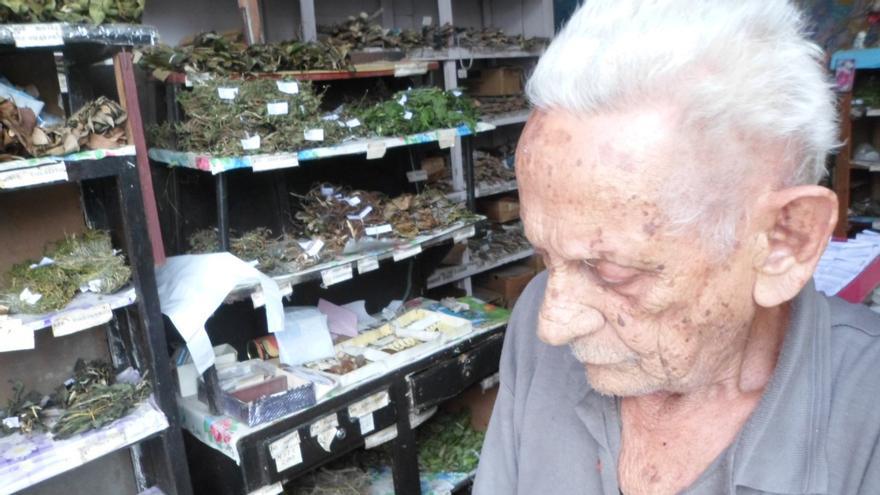
![]() 14ymedio, Carlos A. Torres Fleites, Santa Clara, 15 February 2018 — Since Florentino Cárdenas began selling medicinal herbs two decades ago, he has never seen the demand like in recent months. His clientele in the city of Santa Clara has been growing in sync with the rate at which pharmacies are running out of medicines.
14ymedio, Carlos A. Torres Fleites, Santa Clara, 15 February 2018 — Since Florentino Cárdenas began selling medicinal herbs two decades ago, he has never seen the demand like in recent months. His clientele in the city of Santa Clara has been growing in sync with the rate at which pharmacies are running out of medicines.
More than the desire to rescue an ancient tradition, the resurgent interest in infusions and herbal teas is due to the paucity of painkillers, antipyretics and anti-inflammatories in the state pharmacy network, this herbalist with a shop on the corner of Martí and Maceo streets tells 14ymedio.
Every day, many customers visit Cárdenas in the small room where he treasures his products. They look for plants to alleviate health problems or for religious ceremonies. On the shelves, tied with leaves, are bits of branches and small envelopes with dry products.
Nearby, in a central pharmacy, the shelves have only a few products. “We continue to have a poor supply,” confirms the employee. “We do not have any of the drugs in greatest demand such as dipyrone, paracetamol, azithromycin, clobetasol, ketoconazole or triamcinolone.”
A lady who comes asking for a medicine to lower fever decides to continue on to Cardenas’s shop after receiving a negative response. “When there is no bread you have to eat cassava,” she says ironically, “so when there are no medications you have to use herbs to alleviate the problem.”
During the economic crisis of the 1990s, officially dubbed the Special Period, the lack of medications led the Ministry of Public Health to promote the consumption of medicinal plants. Some family medical clinics even had their own nurseries.
The Ministry also created a National Program of Natural and Traditional Medicine, but many patients reject these methods because they consider them archaic and prefer a commercial drug, according to several opinions collected by this newspaper.
Martha Fuentes, a family doctor in an office associated with the people’s council district of Santa Clara University, encourages the use of medicinal plants and natural products. “Whenever I can, I advise that they use them and I explain their benefits,” she says.
The specialist regrets that there is only one green medicine laboratory in the city administered by the Public Health authorities, which she believes is underutilized, barely producing some syrups.
In the center of the Island there are more than 60 species of medicinal plants, belonging to 30 botanical families, frequently used by residents. Most commonly the leaves are used, but other parts are as well, such as the bark or the roots, says Gumersindo Cabrera, a scholar of the subject.
“In families, the main promoters of these herbs are almost always grandparents and many curative uses are being lost due to the advancement of drugs,” explains Cabrera. “However, when there are times like these, the concoctions and herb plasters are used again.”
Since last year the shortage of medicines has become a source of stress for many patients on the island. The Ministry of Public Health and BioCubaFarma acknowledged that since last June they are seeing “major effects” due to supply problems, which stem from non-payment to distributors.
“People have had to choose more phytopharmaceuticals [from plants] with therapeutic, tonic, digestive, laxative, diuretic and antirheumatic properties; the use of plants with anti-inflammatory and expectorant qualities has also grown,” says Cabrera, who adds to the list of products honey and propolis (“bee glue”).
However, he recommends “consulting a specialist before consuming any of these remedies, because they can also cause adverse reactions.”
For Florentino Cárdenas plants should not be consumed only as an alternative to the shortage of drugs. With a book by Cuban researcher and botanist Juan Tomás Roig, the old man talks to several clients about the advantages of using these natural remedies instead of tablets.
The vendor is supplied by some growers from the rural areas of the province but also harvests several of the herbs in his own garden. This ensures that his product is fresh and recently collected when the customer takes it.
While listing the species he has planted in his own home, he moves between shelves overcrowded with chamomile, guava leaves, guajaca, yagruma and mastuerzo roots.
“At first it was very difficult, I was classified as a witch and even a scammer. Many distrusted me and questioned that these products were sold publicly, and I even had some enemies who came to accuse me before the authorities,” laments Cárdenas.
Time and necessity helped to make his worst critics come to accept his remedies. Now, those detractors of yesteryear also come to the shop to buy sticks of eucalyptus, guajaca, aloe or the very popular moringa.
____________________
The 14ymedio team is committed to serious journalism that reflects the reality of deep Cuba. Thank you for joining us on this long road. We invite you to continue supporting us, but this time by becoming a member of 14ymedio. Together we can continue to transform journalism in Cuba.
